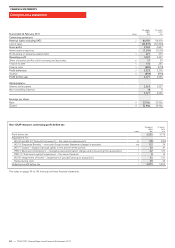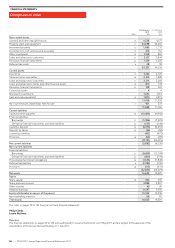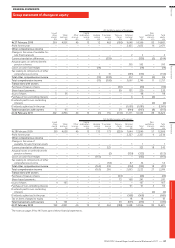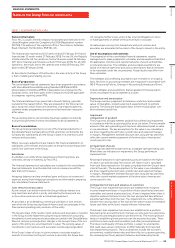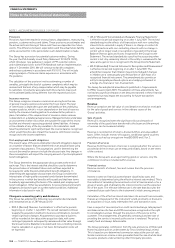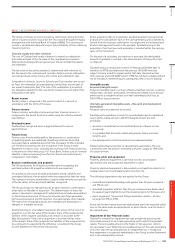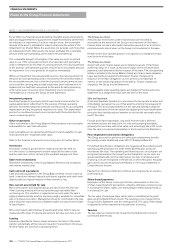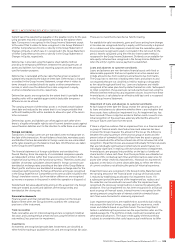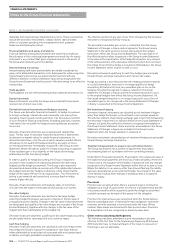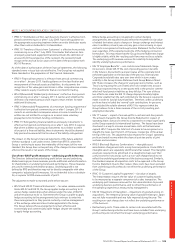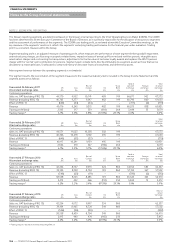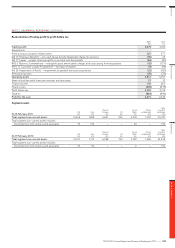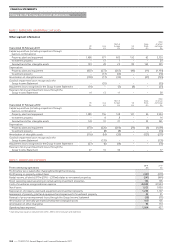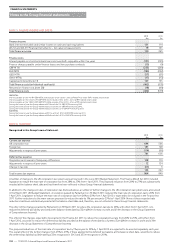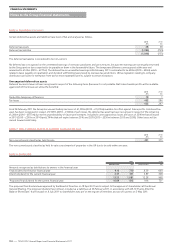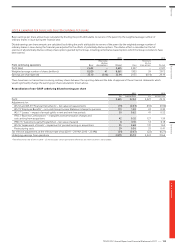Tesco 2011 Annual Report Download - page 108
Download and view the complete annual report
Please find page 108 of the 2011 Tesco annual report below. You can navigate through the pages in the report by either clicking on the pages listed below, or by using the keyword search tool below to find specific information within the annual report.
materially from reported loan impairment provisions. These uncertainties
include the economic environment, notably interest rates and their
effect on customer spending, the unemployment level, payment
behaviour and bankruptcy trends.
Financial liabilities and equity instruments
Financial liabilities and equity instruments are classified according to
the substance of the contractual arrangements entered into. An equity
instrument is any contract that gives a residual interest in the assets of
the Group after deducting all of its liabilities.
Interest-bearing borrowings
Interest-bearing bank loans and overdrafts are initially recorded at fair
value, net of attributable transaction costs. Subsequent to initial recognition,
interest-bearing borrowings are stated at amortised cost with any
difference between cost and redemption value being recognised in the
Group Income Statement over the period of the borrowings on an effective
interest basis.
Trade payables
Trade payables are non interest-bearing and are stated at amortised cost.
Equity instruments
Equity instruments issued by the Group are recorded at the proceeds
received, net of direct issue costs.
Derivative financial instruments and hedge accounting
The Group uses derivative financial instruments to hedge its exposure
to foreign exchange, interest rate and commodity risks arising from
operating, financing and investing activities. The Group does not hold
or issue derivative financial instruments for trading purposes, however,
if derivatives do not qualify for hedge accounting they are accounted
for as such.
Derivative financial instruments are recognised and stated at fair
value. The fair value of derivative financial instruments is determined
by reference to market values for similar financial instruments, by
discounted cash flows, or by the use of option valuation models. Where
derivatives do not qualify for hedge accounting, any gains or losses
on remeasurement are immediately recognised in the Group Income
Statement. Where derivatives qualify for hedge accounting, recognition
of any resultant gain or loss depends on the nature of the hedge
relationship and the item being hedged.
In order to qualify for hedge accounting, the Group is required to
document from inception the relationship between the item being
hedged and the hedging instrument. The Group is also required to
document and demonstrate an assessment of the relationship between
the hedged item and the hedging instrument, which shows that the
hedge will be highly effective on an ongoing basis. This effectiveness
testing is performed at each period end to ensure that the hedge
remains highly effective.
Derivative financial instruments with maturity dates of more than
one year from the balance sheet date are disclosed as non-current.
Fair value hedging
Derivative financial instruments are classified as fair value hedges
when they hedge the Group’s exposure to changes in the fair value of
a recognised asset or liability. Changes in the fair value of derivatives that
are designated and qualify as fair value hedges are recorded in the Group
Income Statement, together with any changes in the fair value of the
hedged item that is attributable to the hedged risk.
Derivative financial instruments qualifying for fair value hedge accounting
are principally interest rate swaps and cross currency swaps.
Cash flow hedging
Derivative financial instruments are classified as cash flow hedges when
they hedge the Group’s exposure to variability in cash flows that are
either attributable to a particular risk associated with a recognised asset
or liability, or a highly probable forecasted transaction.
The effective element of any gain or loss from remeasuring the derivative
instrument is recognised directly in equity.
The associated cumulative gain or loss is reclassified from the Group
Statement of Changes in Equity and recognised in the Group Income
Statement in the same period or periods during which the hedged
transaction affects the Group Income Statement. The classification of
the effective portion when recognised in the Group Income Statement
is the same as the classification of the hedged transaction. Any element
of the remeasurement of the derivative instrument which does not meet
the criteria for an effective hedge is recognised immediately in the Group
Income Statement within finance income or costs.
Derivative instruments qualifying for cash flow hedging are principally
forward foreign exchange transactions and interest rate swaps.
Hedge accounting is discontinued when the hedging instrument expires
or is sold, terminated or exercised, or no longer qualifies for hedge
accounting. At that point in time, any cumulative gain or loss on the
hedging instrument recognised in equity is retained in the Group
Statement of Changes in Equity until the forecasted transaction occurs
or the original hedged item affects the Group Income Statement. If a
forecasted hedged transaction is no longer expected to occur, the net
cumulative gain or loss recognised in the Group Statement of Changes
in Equity is reclassified to the Group Income Statement.
Net investment hedging
Derivative financial instruments are classified as net investment hedges
when they hedge the Group’s net investment in an overseas operation.
The effective element of any foreign exchange gain or loss from remeasuring
the derivative instrument is recognised directly in the Group Statement of
Changes in Equity. Any ineffective element is recognised immediately in
the Group Income Statement. Gains and losses accumulated in the Group
Statement of Changes in Equity are included in the Group Income
Statement when the foreign operation is disposed of.
Derivative instruments designated as net investment hedges are principally
forward foreign exchange transactions.
Treatment of agreements to acquire non-controlling interests
The Group has entered into a number of agreements to purchase
the remaining shares of subsidiaries with non-controlling interests.
Under IAS 32 ‘Financial Instruments: Presentation’, the net present value of
the expected future payments are shown as a financial liability. At the end
of each period, the valuation of the liability is reassessed with any changes
recognised in the Group Income Statement within finance income or costs.
Where the liability is in a currency other than Pounds Sterling, the liability
has been designated as a net investment hedge. Any change in the value
of the liability resulting from changes in exchange rates is recognised
directly in equity.
Provisions
Provisions are recognised when there is a present legal or constructive
obligation as a result of a past event, for which it is probable that a transfer
of economic benefits will be required to settle the obligation and where
a reliable estimate can be made of the amount of the obligation.
Provisions for onerous leases are recognised when the Group believes
that the unavoidable costs of meeting the lease obligations exceed the
economic benefits expected to be received under the lease. Where
material, these leases are discounted to their present value. Provisions
for dilapidation costs are recognised on a lease by lease basis.
Other recent accounting developments
The following standards, amendments and interpretations became
effective for the first time for the financial year beginning 28 February
2010 but either have no material impact on the result or net assets of
the Group or are not applicable.
NOTE 1 ACCOUNTING POLICIES CONTINUED
FINANCIAL STATEMENTS
104
—
TESCO PLC Annual Report and Financial Statements 2011
Notes to the Group financial statements


